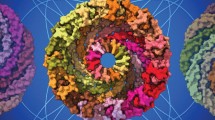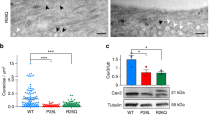Summary
Caveolins are small integral membrane proteins with a vital role in the formation and function of caveolae. In this review, the role of caveolin-3, a predominantly muscle-specific member of the caveolin family, will be examined. We speculate that insights into the mechanism of caveolae formation may give clues into the formation of another plasma membrane domain, the transverse-tubule system of muscle cells and propose a role for cholesterol-enriched lipid “rafts” in this process. In addition, we review recent findings regarding caveolin-3 in differentiated muscle cells and, particularly, in dystrophic muscle.
Similar content being viewed by others
Abbreviations
- DIG:
-
detergent-insoluble glycosphingolipid-enriched complex
- DPC:
-
dystrophin protein complex
- eNOS/nNOS:
-
endothelial/neuronal nitric oxide synthase
- pTT:
-
precursor transverse tubule
- T-tubule:
-
transverse tubule
References
Ahmed SN, Brown DA, London E (1997) On the origin of sphingolipid/cholesterol-rich detergent-insoluble cell membranes: physiological concentrations of cholesterol and sphingolipid induce formation of a detergent-insoluble, liquid-ordered lipid phase in model membranes. Biochemistry 36: 10944–10953
Anderson HA, Chen Y, Norkin LC (1996) Bound simian virus 40 translocates to caveolin-enriched membrane domains, and its entry is inhibited by drugs that selectively disrupt caveolae. Mol Biol Cell 7: 1825–1834
Bist A, Fielding PE, Fielding CJ (1997) Two sterol regulatory element-like sequences mediate up-regulation of caveolin gene transcription in response to low density lipoprotein free cholesterol. Proc Natl Acad Sci USA 94: 10693–10698
Bonilla E, Fischbeck K, Schotland DL (1981) Freeze-fracture studies of muscle caveolae in human muscular dystrophy. Am J Pathol 104: 167–173
Brown D (1993) The tyrosine kinase connection: how GPI-anchored proteins activate T cells. Curr Opin Immunol 5: 349–354
Carozzi A, Ikonen E, Lindsay M, Parton RG (2000) Role of cholesterol in developing T-tubules: analogous mechanisms for tubule and caveolae biogenesis. Traffic 1: 326–341
Couet J, Li S, Okamoto T, Ikezu T, Lisanti MP (1997) Identification of peptide and protein ligands for the caveolin-scaffolding domain: implications for the interaction of caveolin with caveolae-associated proteins. J Biol Chem 272: 6525–6533
Crosbie RH, Yamada H, Venzke DP, Lisanti MP, Campbell KP (1998) Caveolin-3 is not an integral component of the dystrophin glycoprotein complex. FEBS Lett 427: 279–282
Damke H, Baba T, Warnock DE, Schmid SL (1994) Induction of mutant dynamin specifically blocks endocytic coated vesicle formation. J Cell Biol 127: 915–934
Emans N, Gorvel J-P, Walter C, Gerke V, Kellner R, Griffiths G, Gruenberg J (1993) Annexin II is a major component of fusogenic endosomal vesicles. J Cell Biol 120: 1357–1369
Ezerman EB, Ishikawa H (1967) Differentiation of the sarcoplasmic reticulum and T-system in developing chick skeletal muscle in vitro. J Cell Biol 35: 405–420
Feron O (1999) Intracellular localization and activation of endothelial nitric oxide synthase. Curr Opin Nephrol Hypertens 8: 55–59
Fielding CJ, Fielding PE (1997) Intracellular cholesterol transport. J Lipid Res 38: 1503–1521
—, Bist A, Fielding PE (1997) Caveolin mRNA levels are up-regulated by free cholesterol and down-regulated by oxysterols in fibroblast monolayers. Proc Natl Acad Sci USA 94: 3753–3758
Fielding PE, Fielding CJ (1995) Plasma membrane caveolae mediate the efflux of cellular free cholesterol. Biochemistry 34: 14288–14292
Flucher BE (1992) Structural analysis of muscle development: transverse tubules, sarcoplasmic reticulum, and the triad. Dev Biol 154: 245–260
—, Terasaki M, Chin H, Beeler T, Daniels MP (1991) Biogenesis of transverse tubules in skeletal muscle in vitro. Dev Biol 145: 77–90
—, Takekura H, Franzini-Armstrong C (1993) Development of the excitation-contraction coupling apparatus in skeletal muscle: association of sarcoplasmic reticulum and transverse tubules with myofibrils. Dev Biol 160: 135–147
Fra AM, Williamson E, Simons K, Parton RG (1994) Detergent-insoluble glycolipid microdomains in lymphocytes in the absence of caveolae. J Biol Chem 269: 30745–30748
— — — — (1995a) De novo formation of caveolae in lymphocytes by expression of VIP21-caveolin. Proc Natl Acad Sci USA 92: 8655–8659
—, Masserini M, Palestini P, Sonnino S, Simons K (1995b) A photoreactive derivative of ganglioside GM1 specifically cross-links VIP21-caveolin on the cell surface. FEBS Lett 375: 11–14
Franzini-Armstrong C (1991) Simultaneous maturation of transverse tubules and sarcoplasmic reticulum during muscle differentiation in the mouse. Dev Biol 146: 353–362
—, Landmesser L, Pilar G (1975) Size and shape of transverse tubule openings in frog twitch muscle fibres. J Cell Biol 64: 493–497
Friedrichson T, Kurzchalia TV (1998) Microdomains of GPI-anchored proteins in living cells revealed by crosslinking. Nature 394: 802–805
Hailstones D, Sleer LS, Parton RG, Stanley KK (1998) Regulation of caveolin and caveolae by cholesterol in MDCK cells. J Lipid Res 39: 369–379
Hancock JF, Paterson H, Marshall CJ (1990) A polybasic domain or palmitoylation is required in addition to the CAAX motif to localize p21ras to the plasma membrane. Cell 63: 133–139
Harder T, Simons K (1997) Caveolae, DIGs, and the dynamics of sphingolipid-cholesterol microdomains. Curr Opin Cell Biol 9: 534–542
—, Kellner R, Parton RG, Gruenberg J (1997) Specific release of membrane-bound annexin II and cortical cytoskeletal elements by sequestration of membrane cholesterol. Mol Biol Cell 8: 533–545
—, Scheiffele P, Verkade P, Simons K (1998) Lipid domain structure of the plasma membrane revealed by patching of membrane components. J Cell Biol 141: 929–942
Henley JR, Krueger EW, Oswald BJ, McNiven MA (1998) Dynamin-mediated internalization of caveolae. J Cell Biol 141: 85–99
Ishikawa H (1968) Formation of elaborate networks of T-system tubules in cultured skeletal muscle with special reference to the T-system formation. J Cell Biol 38: 51–66
Kameya S, Miyagoe Y, Nonaka I, Ikemoto T, Endo M, Hanaoka K, Nabeshima Y, Takeda S (1999) Alphal-syntrophin gene disruption results in the absence of neuronal-type nitric-oxide synthase at the sarcolemma but does not induce muscle degeneration. J Biol Chem 274: 2193–2200
Keller P, Simons K (1998) Cholesterol is required for surface transport of influenza virus hemagglutinin. J Cell Biol 140: 1357–1367
Lafont F, Lecat S, Verkade R, Simons K (1998) Annexin XIIIb associates with lipid microdomains to function in apical delivery. J Cell Biol 142: 1413–1427
Lau YH, Caswell AH, Brunschwig JP (1977) Isolation of transverse tubules by fractionation of triad junctions of skeletal muscle. J Biol Chem 252: 5565–5574
— —, Baerwald R, Garcia M (1979) Lipid analysis and freeze-fracture studies on isolated transverse tubules and sarcoplasmic reticulum subfractions of skeletal muscle. J Biol Chem 254: 540–546
Lilling G, Beitner R (1991) Altered allosteric properties of cytoskeleton-bound phosphofructokinase in muscle from mice with X chromosome-linked muscular dystrophy (mdx). Biochem Med Metab Biol 45: 319–325
Lipardi C, Mora R, Colomer V, Paladino S, Nitsch L, Rodriguez-Boulan E, Zurzolo C (1998) Caveolin transfection results in caveolae formation but not apical sorting of glycosylphosphatidylinositol (GPI)-anchored proteins in epithelial cells. J Cell Biol 140: 617–626
Luetterforst R, Stang E, Zorzi N, Carozzi A, Way M, Parton RG (1999) Molecular characterization of caveolin association with the Golgi complex; identification of a cis Golgi targeting domain in the caveolin molecule. J Cell Biol 145: 1443–1459
McLean B, Mazen LL, Shotton DM (1986) Quantitative freeze-fracture studies of membrane changes in chicken muscular dystrophy. Muscle Nerve 9: 501–514
McNally EM, de Sa Moreira E, Duggan DJ, Bonnemann CG, Lisanti MP, Lidov HGW, Vainzof M, Passos-Bueno MR, Hoffman EP, Zatz M, Kunkel LM (1998) Caveolin-3 in muscular dystrophy. Hum Mol Genet 7: 871–877
Miike T, Nonaka I, Ohtani Y, Tamari H, Ishitsu T (1984) Behaviour of sarcotubular system formation in experimentally induced regeneration of muscle fibers. J Neurol Sci 65: 193–200
Minetti C, Sotgia F, Bruno C, Scartezzini P, Broda P, Bado M, Masetti E, Mazzocco M, Egeo A, Donati MA, Volonte D, Galbiati F, Cordone G, Bricarelli FD, Lisanti MP, Zara F (1998) Mutations in the caveolin-3 gene cause autosomal dominant limb-girdle muscular dystrophy. Nat Genet 18: 365–368
Murata M, Peranen J, Schreiner R, Wieland F, Kurzchalia TV, Simons K (1995) VIP21/caveolin is a cholesterol-binding protein. Proc Natl Acad Sci USA 92: 10339–10343
Oh P, McIntosh DP, Schnitzer JE (1998) Dynamin at the neck of caveolae mediates their budding to form transport vesicles by GTP-driven fission from the plasma membrane of endothelium. J Cell Biol 141: 101–114
Okamoto T, Schlegel A, Scherer PE, Lisanti MP (1998) Caveolins, a family of scaffolding proteins for organizing “preassembled signaling complexes” at the plasma membrane. J Biol Chem 273: 5419–5422
Parton RG (1996) Caveolae and caveolins. Curr Opin Cell Biol 8: 542–548
—, Simons K (1995) Digging into caveolae. Science 269: 1398–1399
—, Joggerst B, Simons K (1994) Regulated internalization of caveolae. J Cell Biol 127: 1199–1215
—, Way M, Zorzi N, Stang E (1997) Caveolin-3 associates with developing T-tubules during muscle differentiation. J Cell Biol 136: 137–115
Ralston E, Ploug T (1999) Caveolin-3 is associated with the T-tubules of mature skeletal muscle fibers. Exp Cell Res 246: 510–515
Rosemblatt M, Hidalgo C, Vergara C, Ikemoto N (1981) Immunological and biochemical properties of transverse tubule membranes isolated from rabbit skeletal muscle. J Biol Chem 256: 8140–8148
Roy S, Luetterforst R, Harding A, Apolloni A, Etheridge M, Stang E, Rolls B, Hancock JF, Parton RG (1999) Dominant-negative caveolin inhibits H-Ras function by disrupting cholesterol-rich plasma membrane domains. Nat Cell Biol 1: 98–105
Scherer PE, Lisanti MP (1997) Association of phosphofructokinase-M with caveolin-3 in differentiated skeletal myotubes: dynamic regulation by extracellular glucose and intracellular metabolites. J Biol Chem 272: 20698–20705
Schlegel A, Volonte D, Engelman JA, Galbiati F, Mehta P, Zhang XL, Scherer PE, Lisanti MP (1998) Crowded little caves: structure and function of caveolae. Cell Signal 10: 457–463
Schnitzer JE, Oh P, Pinney E, Allard J (1994) Filipin-sensitive caveolae-mediated transport in endothelium: reduced transcytosis, scavenger endocytosis, and capillary permeability of select macromolecules. J Cell Biol 127: 1217–1232
Schroeder R, London E, Brown D (1994) Interactions between saturated acyl chains confer detergent resistance on lipids and glycosylphosphatidylinositol (GPI)-anchored proteins: GPI-anchored proteins in liposomes and cells show similar behavior. Proc Natl Acad Sci USA 91: 12130–12134
Simionescu M, Simionescu N (1991) Endothelial transport of macromolecules: transcytosis and endocytosis. Cell Biol Rev 25: 1–80
Simons K, Ikonen E (1997) Functional rafts in cell membranes. Nature 387: 569–672
Song KS, Scherer PE, Tang Z, Okamoto T, Li S, Chafel M, Chu C, Kohtz DS, Lisanti MP (1996) Expression of caveolin-3 in skeletal, cardiac and smooth muscle cells. J Biol Chem 271: 15160–15165
Stang E, Kartenbeck J, Parton RG (1997) Major histocompatibility complex class I molecules mediate association of SV40 with caveolae. Mol Biol Cell 8: 47–57
Tang Z, Scherer PE, Okamoto T, Song K, Chu C, Kohtz DS, Nishimoto I, Lodish HF, Lisanti MP (1996) Molecular cloning of caveolin-3, a novel member of the caveolin gene family expressed predominantly in muscle. J Biol Chem 271: 2255–2261
Van Deurs B, Holm PK, Sandvig K, Hansen SH (1993) Are caveolae involved in endocytosis? Trends Cell Biol 3: 249–251
Varma R, Mayor S (1998) GPI-anchored proteins are organized in submicron domains at the cell surface. Nature 394: 798–801
Venema VJ, Ju H, Zou R, Venema RC (1997) Interaction of neuronal nitric-oxide synthase with caveolin-3 in skeletal muscle: identification of a novel caveolin scaffolding/inhibitory domain. J Biol Chem 272: 28187–28190
Way M, Parton RG (1995) M-caveolin, a muscle-specific caveolin-related protein. FEBS Lett 376: 108–112
Yuan SH, Arnold W, Jorgensen AO (1991) Biogenesis of transverse tubules and triads: immunolocalization of the 1,4-dihydropyridine receptor, TS28, and the ryanodine receptor in rabbit skeletal muscle developing in situ. J Cell Biol 112: 289–301
Author information
Authors and Affiliations
Rights and permissions
About this article
Cite this article
Parton, R.G., Carozzi, A. & Gustavsson, J. Caves and labyrinths: caveolae and transverse tubules in skeletal muscle. Protoplasma 212, 15–23 (2000). https://doi.org/10.1007/BF01279343
Received:
Accepted:
Issue Date:
DOI: https://doi.org/10.1007/BF01279343




